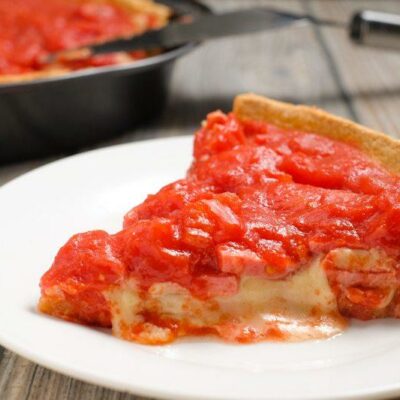
Semolina Flour Pizza Dough
Speed - 97%
Simplicity - 97%
Tastiness - 98%
97%
Excellent!
This pizza dough came out perfectly chewy and airy. It also baked with beautifully golden edges.

Ingredients
- 1.5 Cups Semolina Flour
- 1.5 Cups Gluten-Free All-Purpose Flour
- 1 Cup Warm Water
- 1/4 Cup olive oil
- 1 Teaspoon Sugar
- 1 Teaspoon Salt
- 1 Tablespoon Active Dry Yeast
Instructions
- Combine the water, sugar, and yeast in a bowl. Set aside for 10 minutes.
- Whisk together the semolina flour, gluten-free all-purpose flour, and salt in a bowl.
- Stir the active yeast mixture into the dry ingredients.
- Knead the dough on a lightly floured surface.
- Leave the dough to rise for an hour in a lightly oiled bowl.
- Stretch the dough.
- Top your pizza and bake for 20 minutes at 425F.
This has been the closest I’ve got to a typical pizza dough, having used several gluten-free flour alternatives. Semolina flour just made this dough really elastic and airy. However, please be aware that semolina flour itself isn’t gluten-free, even though the other flour types in this recipe are.
Let’s start by activating some yeast in sugar and warm water.

While waiting for the yeast to bloom, whisk together the dry ingredients – gluten-free all-purpose flour, semolina flour, and salt.
You may use a pre-mixed gluten-free flour blend or use a recipe which you may already have.
Here’s a blend that works well for my baking:
- 220 grams Brown Rice Flour
- 80 grams Potato Starch
- 25 grams Tapioca Starch
- 40 grams Cornmeal
- 7 grams Xanthan Gum
If you’re using a ready to use gluten-free bread mix, that may also contain xanthan gum. Go check the label.

Once the yeast has gone bubbly, it’s ready to get it into the dry ingredients. Stir just until everything comes together into a smooth dough.

Knead the ball of dough on a lightly floured surface for about 5-7 minutes. It should turn out smooth and elastic.

Set the dough in a lightly oiled bowl and leave it to rise for an hour to an hour and a half.

This dough will rise beautifully.

This dough will be really elastic. You can flatten it out with a rolling pin, or stretch it by hand.

Set the dough onto a baking pan or pizza stone.
The toppings can go on now without any need for pre-baking.

Look at how airy and very bread-like this crust has become.





Ingredients
- 1.5 Cups Semolina Flour
- 1.5 Cups Gluten-Free All-Purpose Flour
- 1 Cup Warm Water
- 1/4 Cup olive oil
- 1 Teaspoon Sugar
- 1 Teaspoon Salt
- 1 Tablespoon Active Dry Yeast
Instructions
- Combine the water, sugar, and yeast in a bowl. Set aside for 10 minutes.
- Whisk together the semolina flour, gluten-free all-purpose flour, and salt in a bowl.
- Stir the active yeast mixture into the dry ingredients.
- Knead the dough on a lightly floured surface.
- Leave the dough to rise for an hour in a lightly oiled bowl.
- Stretch the dough.
- Top your pizza and bake for 20 minutes at 425F.
Now we’re cooking! But are you stuck indoors with hot pizza oven while it’s sunny and beautiful weather outside? Sounds terrible. During the summer I cook my pizza outdoors on a pizza stone and grill. It’s a lot of fun, and it’s a great way to get out of the house, even while making pizza!
Semolina Flour
Semolina flour is an alternative to regular wheat flour. But, it isn’t a gluten-free option. For that matter, semolina is actually produced from wheat middlings, which are a byproduct of the flour-making process. Semolina itself is a coarse product and is most common as a base for couscous and in baking.
On the other hand, semolina flour is finely ground. This makes it less course than regular semolina, although the flour is still coarser than wheat flour.
Because it is from wheat, semolina flour does still contain gluten, which is why it behaves in a similar way to regular wheat flour. In fact, semolina is actually higher in gluten than traditional wheat flour.
Semolina flour also has higher protein content than wheat flour. That nutritional difference makes semolina attractive for some recipes, especially if you are trying for more protein in your diet.
Cooking With Semolina Flour
As a wheat-based flour, semolina flour isn’t going to work for anybody gluten intolerant. However, it is still an interesting flour to use, especially if you want more protein or like to vary the flour types that you cook with.
Most of the time, semolina flour is used as a key ingredient in pasta, along with gnocchi. This makes it particularly attractive if you like eating pasta frequently.
But, you aren’t limited to using semolina in this way. Instead, there are other recipes out there that rely on the flour, including pizza doughs like the one in this post, along with cakes and various types of bread.
Like many alternative types of flour, semolina does have a flavor of its own. In particular, it tends to be a little sweet with a degree of complexity that perfectly complements breads and savory dishes.
One traditional option that takes advantage of semolina flour is Altamura bread and the semolina flour helps to create the finished taste and texture of the product. And, of course, you can also turn to pizza dough recipes like the one in this post.
When making it, I relied on a gluten-free all-purpose flour blend. However, you could also get similar results by using a regular all-purpose flour. After all, semolina flour isn’t gluten-free, so your finished pizza will contain gluten regardless.










 Gluten-Free Neapolitan Pizza Recipe
Gluten-Free Neapolitan Pizza Recipe
Leave a Reply